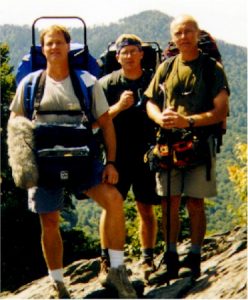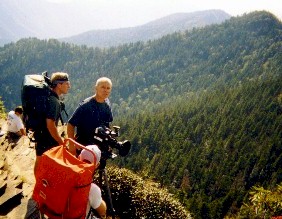Shooting for the National Park Service in Appalachia
I was recently the mixer on a film being made for the National Park Service on The Great Smokey Mountain National Park. The film covers all four seasons at the park and it has been a great way to polish up on some specialty techniques and determine some of the best equipment to use.
While very little of this film involves sync dialog, there is a high degree of importance given to realistic natural ambience. For this reason, and because the final product will be mixed in stereo and 5.1 Surround, recording the ambience track in stereo is a must. Whenever possible, the director wanted to have all of the ambience transferred in sync, which meant using a timecode recorder and slate.
This project also involves a good bit of overnight wilderness hiking, so portability was also required; i.e. small, lightweight, battery powered.

Mt. Le Conte
Great Smokey Mountains
Nat’l Park
(L to R) Glen Trew, mixer; Kip McDonald, camera assistant; Sonny Hutchison, director/producer
Here is the list of equipment I chose:
- Fostex PD-4 Timecode DAT Recorder (see Fostex PD4 review by Glen Trew)
- Portabrace bag w/RM Multi top pouch
- Portabrace AH-2 harness (an absolute life saver!!!)
- Sony ECM MS-5 Stereo Mic with Rycote windscreen system (Zeppelin, Suspension and Windjammer)
- Denecke TS-2 timecode slate (with Comtek wireless system)
- U.S. Broadcast NP-2 batteries (12 volt/4.5 Ahr!)
The Fostex PD-4 is pretty well covered in another current article (see The Venerable Fostex PD-4 Portable Timecode DAT Recorder). For the record, I must mention that the Fostex PD-4 survived the mountain rigors of snow and ice in the winter, thunderstorms in the spring, extreme humidity in the summer and running from bears in the fall; all without a single glitch from the machine or complaint from me. What else is there to say about this machine?
Most of this film required hiking. Some not so long, but others would be considered substantial. For the very short hikes, the Portabrace bag and shoulder strap was sufficient for the PD-4. For anything more than a half mile, however, I would always use the Portabrace AH-2 harness (this harness should not be confused with the earlier model, now known as the AH-1; the AH-2 is very different and far superior).

The Sony ECM MS-5 Stereo mic, while not considered to be in the “best” category, actually performed very well. The post production facility was not familiar with decoding a “mid-side” stereo recording, so I needed a microphone with a left/right output (otherwise I would have used the Pearl
MS-8…more on that later).
The MS-5 has a switch that allows the image width to be selected from 90 to 170 degrees, a low freq. roll-off, and a 10dB pad. One thing this mic really had going for it was that it fit in a Rycote Zeppelin windscreen and suspension intended for a Sennheiser 416 microphone. All that was needed was a change of clips on the suspension.
The only real shortcoming that this Sony stereo mic had was its relatively low level and self noise. This was a factor only when recording ambience in areas of the park that were so quiet that there was no ambience (almost), and even then it was not bad. Imagine being on a mountain covered with pine trees and two feet of fresh snow, the roads have been closed twenty miles back, no wind – now that’s quiet. But I know that sitting in the middle of it again in a surround sound theater will make me glad I’m a soundman.


 US
US  Canada
Canada
Leave a reply
You must be logged in to post a comment.